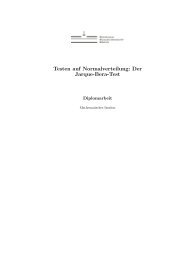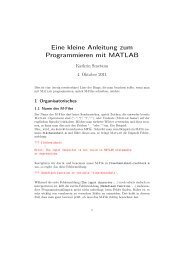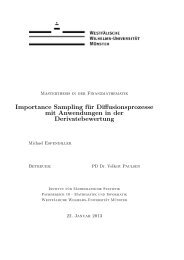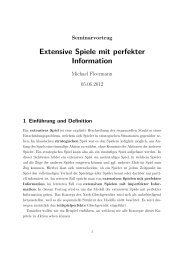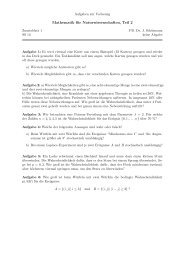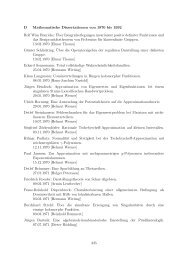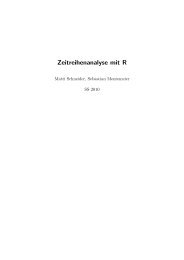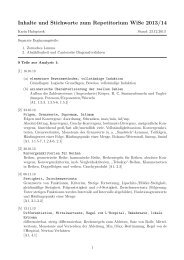Margulis Lemma
Margulis Lemma
Margulis Lemma
Create successful ePaper yourself
Turn your PDF publications into a flip-book with our unique Google optimized e-Paper software.
STRUCTURE OF FUNDAMENTAL GROUPS 11<br />
some group K on C p∞ Y . Let g ∞ ∈ K be the limit of g h . Clearly d(o, g ∞ o) = 1 and<br />
for all a ∈ K with d(o, ao) ≤ 0.51 we have d(go, ao) ≥ 0.51. In particular the orbit<br />
K ⋆ o is not convex.<br />
Because X = Y/G the quotient C˜p∞ Y/K is isometric to lim h→∞ ( 1<br />
ε h<br />
X, p ∞ ) which<br />
by assumption is isometric to some Euclidean space R k .<br />
As in the proof of <strong>Lemma</strong> 2.3 it follows that C˜p∞ Y is isometric to R k × Z and<br />
the orbits of the action of K are given by v × Z where v ∈ R k . In particular, the K<br />
orbits are convex – a contradiction.<br />
Clearly, the claim implies that G ⋆ ˜p ∞ ∩ B r (˜p ∞ ) is path connected for r < δ. In<br />
fact, it is now easy to construct a Hölder continuous path from ˜p ∞ to any point in<br />
G ⋆ ˜p ∞ ∩ B r (˜p ∞ ).<br />
Of course, the claim also implies G(ε) = G(δ) for all ε ∈ (0, δ]. Therefore the<br />
first part of <strong>Lemma</strong> 2.4 follows from <strong>Lemma</strong> 2.2.<br />
□<br />
Theorem 3 will follow from the following slightly more general result.<br />
Theorem 2.5. Given n and R there is a constant C such that the following holds.<br />
Suppose (M, g) is a manifold, p ∈ M, B 2R (p) is compact and Ric > −(n − 1) on<br />
B 2R (p). Furthermore, we assume that π 1 (M, g) is generated by loops of length ≤ R.<br />
Then π 1 (M, p) can be generated by C loops of length ≤ R.<br />
Moreover, there is a point q ∈ B R/2 (p) such that any Gromov short generator<br />
system of π 1 (M, q) has at most C elements.<br />
Proof. It is clear that it suffices to show that for a point q ∈ B R/2 (p) the number<br />
of elements in a Gromov short generator system of π 1 (M, q) is bounded above by<br />
some a priori constant.<br />
We consider a Gromov short generator system γ 1 , . . . , γ k of π 1 (M, q). With<br />
|γ i | ≤ |γ i+1 | for some q ∈ B R/2 (p).<br />
Clearly |γ i | ≤ 2R and it easily follows from Bishop–Gromov relative volume<br />
comparison that there are effective a priori bounds (depending only on n, R and r)<br />
for the number of short generators with length ≥ r.<br />
We will argue by contradiction. It will be convenient to modify the assumption<br />
on π 1 being boundedly generated. We call (M i , g i ) a contradicting sequence if the<br />
following holds<br />
• B 3 (p i ) is compact and Ric > −(n − 1) on B 3 (p i ).<br />
• For all q i ∈ B 1 (p i ) the number of short generators of π 1 (M i , q i ) of length<br />
≤ 4 is larger than 2 i .<br />
Clearly it suffices to rule out the existence of a contradicting sequence. We may<br />
assume that (B 3 (p i ), p i ) converges to some limit space (X, p ∞ ). We put<br />
dim(X) = max { k | there is a regular p ∈ B 1/4 (p ∞ ) with C x X ∼ = R k} .<br />
We argue by reverse induction on dim(X). We we start our induction at dim(X) ≥<br />
n + 1. It is well known that this can not happen so there is nothing to prove. The<br />
induction step is subdivided in two substeps.<br />
Step 1. For any contradicting sequence (M i , p i ) converging to (X, p ∞ ) there is a<br />
new contradicting sequence converging to (R dim(X) , 0).<br />
Choose q i ∈ B 1/4 (p i ) converging to some point q ∞ ∈ B 1/4 (p ∞ ) with C q∞ X =



